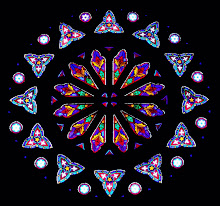
In Franck’s magnificent E major Chorale, there is an obvious blotch in certain editions which appears right next to the tenor voice of a 4-part texture (see dark blue square, upper left example). Whatever the genesis of the blotch, it has led to what I believe are incorrect performances of the passage.
The blotch clearly includes a large, somewhat circular shape, attached to what appears to be the note B in the space above the bass staff. If the B is indeed the composer’s intention, then it must be observed that 1) the lower right corner of the note head is missing, 2) a fifth, non-doubling voice has suddenly been added to the texture, and 3) the added note results in a dissonant 9 - 8 combination with the accented passing tone C sharp in the soprano, thus significantly changing the sonority of the chord.
If we look at the analogous passage later in the piece, with pedals added, we see that the B is not present. Its absence, however, has nothing to do with the added pedal line: the pedal line is simply an octave doubling of the lowest voice in the manuals.
The only sensible conclusion is that the B is part of the smudge. The middle and lower examples on the left show the large part of the blotch, and then the entire blotch, removed. Why does this problem go undetected? The answer is straightforward. The B is indeed possible - after all, it is the root of the prevailing harmony, the B dominant 7th chord. But why would Franck vary the harmony, by omitting the B, in only one instance throughout the course of the later passage, while what is happening in the music in the first place - in the later passage - is a registrational and textural variant of the initial statement?
The stained glass window, lower right, is part of a large panorama on the back wall of St. James the Apostle Church in Carmel, New York. Visit my website - Gallery of Stained Glass Art - at robertfertitta.org.






